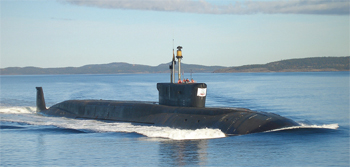In November 2011 Vladimir Putin toured the Sevmash shipyards just outside Arkhangelsk in northern Russia to promote his latest increase in funding for the Russian Navy. The visit coincided with the sea trials of Alexander Nevsky, Russia’s latest Borei class strategic missile submarine, and led to oblique references in the state-controlled Russian media to the problems encountered by the Nevsky and the growing fears of her crew.
The Borei class has been mired in turmoil since its inception. The first boat of the class, Yuri Dolgoruky, was laid down in 1996 just before the Russian financial crisis of the late 1990s. The advance of technology in the intervening years means that, although officially Nevsky has only had minor changes made to her, insiders claim that many of her systems are entirely new and unpredictable.
K-550 Alexander Nevsky was laid down in 2004 and launched in December of 2010. She is powered by a single nuclear reactor and has a pumpjet propulsion unit to minimise her acoustic signature. She carries 107 officers and men and will eventually be armed with 12 or 16 Bulava missiles. Nevsky is the second of a projected eight boats to be divided between the Northern and Pacific fleets.
Nevsky’s sea trials began on 24 October 2011, and before long rumours began to spread of problems encountered and a rising sense of unease among the crew. In addition to a multitude of smaller problems, suspicions rest on the boat’s digitalised control system and the Bulava missiles.Handling failures have become so common that the crew lacks faith in the boat. Morale is lowered even further by the problems surrounding the primary weapons system.
The spectre of Kursk still looms large over the Russian Navy, when an experimental new torpedo detonated inside the sub and the entire crew perished. The Borei class have the most modern safety equipment of any Russian boats yet, but this inspires little faith among men wrestling with faulty equipment and poor construction.


